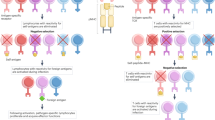Play all audios:

A STRIKING structural feature of several cell surface molecules in warm-blooded vertebrates is the non-covalent association of polypeptide chains (molecular weight (MW) 40–45,000) bearing
alloantigenic determinants, with another molecule, β2-microglobulin (β2m) (MW 11–12,000)1–4. A role for β2m has not been established, but a whole family of cell surface proteins with overall
structural similarity to major transplantation antigens have β2m as a common invariant subunit. The identification of β2m in these proteins has relied mainly on its characteristically low
MW and on the use of heterologous antisera. Human thymus antigen (HTA 1) is a surface antigen found on human thymocytes and certain thymomas like MOLT-4. It has been identified by the
monoclonal antibody from hybrid myeloma NA1/34 and has been suggested to represent the human homologue of the murine TL antigen5. We describe here experiments showing that the heavy chain of
HTA1 is associated with a ‘β2m-like’ subunit which is different from β2m both in its mobility in SDS polyacrylamide gel electrophoresis (PAGE) and in its immunological properties.
Anyone you share the following link with will be able to read this content:
